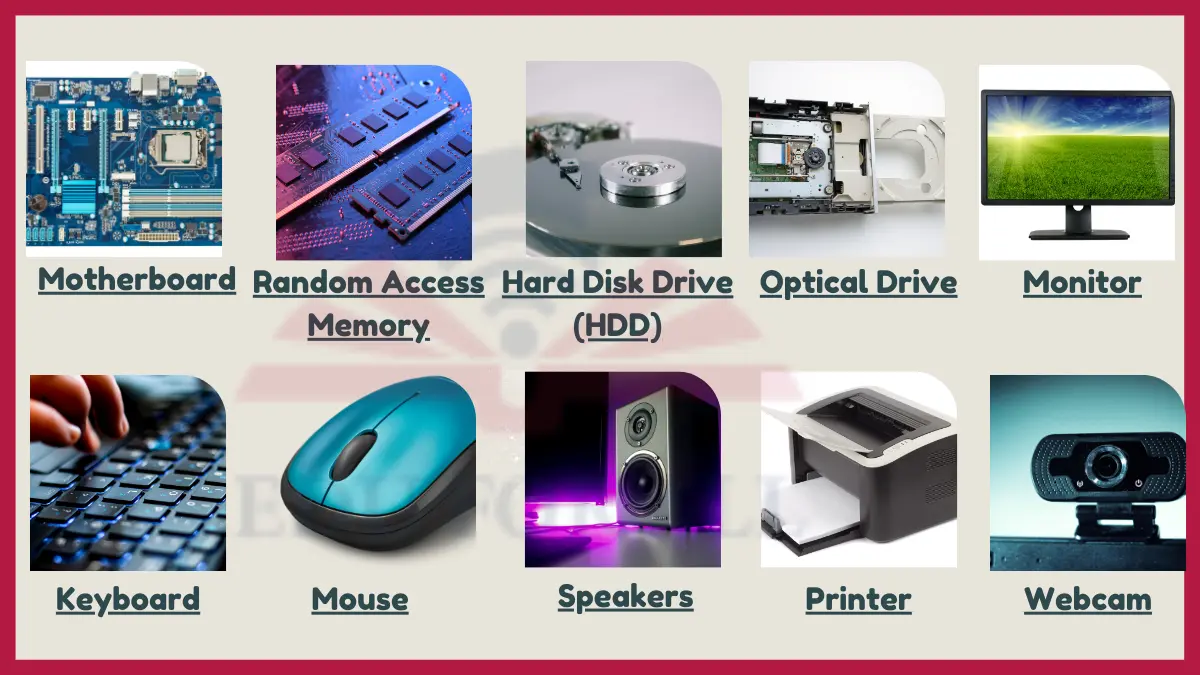CPU, Motherboard, Random Access Memory (RAM), Hard Disk Drive, Solid-State Drive, Monitor, Keyboard, Mouse, Printer, Scanner, Router, and Modem are some most important examples of computer Hardware.

- Examples of Computer Hardware
- 1. Central Processing Unit (CPU)
- 2. Motherboard
- 3. Random Access Memory (RAM)
- 4. Read-Only Memory (ROM)
- 5. Graphics Processing Unit (GPU)
- 6. Hard Disk Drive (HDD)
- 7. Solid-State Drive (SSD)
- 8. Power Supply Unit (PSU)
- 9. Case
- 10. Optical Drive
- 11. Monitor
- 12. Keyboard
- 13. Mouse
- 14. Speakers
- 15. Webcam
- 16. Printer
- 17. Scanner
- 18. Router
- 19. Modem
- 20. Wireless Access Point (WAP)
- 21. Network Adapter
- 22. External Storage Devices
Examples of Computer Hardware
Here are a few examples of Examples of Computer Hardware:
1. Central Processing Unit (CPU)
The CPU is one of the most important examples of computer hardware. It is responsible for carrying out the instructions of the operating system and software applications. It is made up of billions of transistors that are arranged in circuits. These circuits work together to perform calculations and process data.
The CPU is the most important component of the computer, and its speed and performance can have a significant impact on the overall performance of the system. CPUs are typically measured in gigahertz (GHz), and the higher the GHz rating, the faster the CPU will be. However, other factors, such as the number of cores and the cache memory, also play a role in CPU performance.
2. Motherboard
The motherboard is the main circuit board of the computer. It contains the CPU socket, memory slots, expansion slots, and other important components. The motherboard connects all of the other components of the computer together and allows them to communicate with each other.
The motherboard is also important for determining the compatibility of other components in the system. For example, the motherboard must have the correct socket type for the CPU that you want to use. Additionally, the motherboard must have enough memory slots for the amount of RAM that you want to install.
3. Random Access Memory (RAM)
RAM is the computer’s short-term memory. It is used to store data that the CPU is currently using. When you open a program or file, the computer loads it into RAM so that the CPU can access it quickly. The more RAM you have, the more programs you can run at the same time and the faster your computer will run.
RAM is measured in gigabytes (GB), and the more GB of RAM you have, the more data the computer can store in short-term memory. This means that you can run more programs at the same time and switch between them quickly.
4. Read-Only Memory (ROM)
ROM is the computer’s long-term memory. It contains the basic input/output system (BIOS), which is the software that allows the computer to start up and communicate with its hardware. ROM is also used to store other important data, such as the computer’s serial number and product key.
ROM is non-volatile, which means that it retains its contents even when the computer is turned off. This is important because it allows the computer to start up and boot into the operating system.
5. Graphics Processing Unit (GPU)
The GPU is responsible for rendering graphics. It is used to display images on the monitor and to run graphics-intensive programs, such as video games and 3D modeling software. The more powerful your GPU is, the better your computer will be able to render graphics.
GPUs are measured in teraflops (TFLOPs), and the higher the TFLOPs rating, the more powerful the GPU will be. A more powerful GPU will be able to render more complex graphics and run graphics-intensive programs more smoothly.
6. Hard Disk Drive (HDD)
The HDD is the computer’s long-term storage. It is used to store data that is not currently being used by the CPU, such as operating system files, programs, and files. HDDs are relatively slow, but they are also relatively inexpensive and can store a lot of data.
HDDs use spinning platters to store data. The data is written to the platters using a read/write head. When the computer needs to access data, the read/write head moves to the correct location on the platter and reads the data.
7. Solid-State Drive (SSD)
SSDs are a new type of storage that is faster than HDDs. They use flash memory to store data, which does not have any moving parts. This makes them more durable and faster than HDDs. However, SSDs are also more expensive than HDDs and cannot store as much data.
SSDs work by storing data in cells. When the computer needs to write data, it applies a voltage to the cell to change its state. When the computer needs to read data, it checks the state of the cell to determine the value of the data.
8. Power Supply Unit (PSU)
The PSU provides power to all of the other components of the computer. It converts the power from your wall outlet to a voltage that is safe for the computer to use. The PSU is important because it can cause damage to other components if it fails.
9. Case
The case is the metal or plastic box that houses all of the other components of the computer. It protects the components from dust and other damage. The case also helps to keep the components cool.
The case is important because it can affect the overall performance of the computer. For example, a case with poor airflow can cause the components to overheat, which can reduce performance or even damage the components. Additionally, a case with poor cable management can make it difficult to maintain and upgrade the computer.
10. Optical Drive
An optical drive is a device that can read and write data to optical discs, such as CDs, DVDs, and Blu-ray discs. Optical drives are not as common as they used to be, but they are still useful for backing up data and installing software.
Optical drives work by using a laser to read and write data to the optical disc. The laser heats up the disc, which causes the data to be changed. Optical drives are measured in disc formats, such as CD-ROM, DVD-ROM, and Blu-ray-ROM.
11. Monitor
The monitor is the screen that displays the images that the computer generates. Monitors come in a variety of sizes and resolutions. The larger the monitor and the higher the resolution, the better the image quality will be.
Monitors are measured in inches and resolution. The screen size is measured diagonally, and the resolution is measured in pixels. The higher the resolution, the more pixels there are on the screen, which means that the image will be sharper.
12. Keyboard
The keyboard is used to input text and commands into the computer. Keyboards come in a variety of layouts, but the most common layout is the QWERTY layout.
The keyboard works by sending electrical signals to the computer when the keys are pressed. The computer then interprets the signals and takes the appropriate action. For example, if the user presses the “A” key, the computer will display the letter “A” on the screen.
13. Mouse
The mouse is used to control the cursor on the monitor. Mice come in a variety of shapes and sizes, but most mice have two buttons and a scroll wheel.
The mouse works by sending electrical signals to the computer when it is moved. The computer then interprets the signals and moves the cursor on the screen. Additionally, the mouse buttons can be used to click on objects on the screen and to perform other actions.
14. Speakers
Speakers are used to output sound from the computer. Speakers come in a variety of sizes and configurations. The larger the speakers and the more speakers you have, the better the sound quality will be.
Speakers work by converting electrical signals from the computer into sound waves. The electrical signals are sent to the speakers through a cable. The speakers then convert the electrical signals into sound waves by vibrating a diaphragm.
15. Webcam
A webcam is a camera that is used to capture video and images. Webcams are often used for video conferencing and streaming video.
Webcams work by converting light into electrical signals. The electrical signals are then sent to the computer through a cable. The computer then converts the electrical signals into a video or image file.
16. Printer
A printer is used to print documents and images from the computer. Printers come in a variety of types, including laser printers, inkjet printers, and all-in-one printers.
Laser printers work by using a laser to create an image on a drum. The drum is then coated with toner and the image is transferred to paper. Inkjet printers work by spraying ink onto paper. All-in-one printers combine the functionality of a printer, scanner, and copier into a single device.
17. Scanner
A scanner is used to scan documents and images into the computer. Scanned documents and images can be saved as files or printed.
Scanners work by using a light source to scan the document or image. The reflected light is then converted into electrical signals by a sensor. The electrical signals are then sent to the computer and converted into a digital image file.
18. Router
A router is a device that connects multiple computers to the internet. It forwards data packets between the computers and the internet.
Routers are important because they allow multiple computers to share a single internet connection. Additionally, routers can provide security features, such as firewalls and intrusion detection systems.
19. Modem
A modem is a device that converts digital signals from the computer to analog signals that can be transmitted over telephone lines.
Modems are important because they allow computers to connect to the internet over telephone lines. Modems are typically measured in bits per second (bps), and the higher the bps rating, the faster the modem will be able to transmit data.
20. Wireless Access Point (WAP)
A WAP is a device that allows computers to connect to the internet wirelessly.
WAPs work by creating a wireless network that computers can connect to. WAPs are typically measured in megabits per second (Mbps), and the higher the Mbps rating, the faster the wireless network will be able to transmit data.
21. Network Adapter
A network adapter is a device that allows a computer to connect to a network. Network adapters come in a variety of types, including wired network adapters and wireless network adapters.
Wired network adapters connect to a network using a cable. Wireless network adapters connect to a network using radio waves. Network adapters are typically measured in Mbps, and the higher the Mbps rating, the faster the network adapter will be able to transmit data.
22. External Storage Devices
External storage devices are devices that can be used to store data outside of the computer. External storage devices include hard drives, flash drives, and optical drives.
External hard drives are similar to internal hard drives, but they are designed to be connected to a computer externally. External flash drives are small, portable devices that can be used to store data. Optical drives are devices that can read and write data to optical discs, such as CDs, DVDs, and Blu-ray discs.

